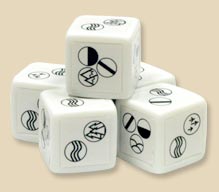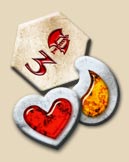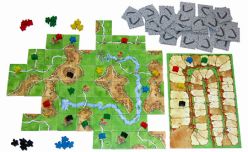Board Games
March 16, 2006 - Games
Recently, because we wanted some activity at home that didn't involve sitting in front of the TV, my wife and I picked up a couple board games, and I was really surprised at how much I enjoy them.
 The first one we tried was Runebound, which we got because it looked a lot like the Diablo or Baldur's Gate style RPGs we've played together before on PC on PS2. So we played the game, and it played much like the Diablo or Baldur's Gate style RPGs we've played together before on PC on PS2. Honestly though, Runebound is a good game despite following that Gauntlet formula of kill monsters, get experience, collect gold, go up levels, buy equipment, hire henchmen, kill tougher monsters. It works surprisingly well in a board game, and they've developed a very workable combat system.
The first one we tried was Runebound, which we got because it looked a lot like the Diablo or Baldur's Gate style RPGs we've played together before on PC on PS2. So we played the game, and it played much like the Diablo or Baldur's Gate style RPGs we've played together before on PC on PS2. Honestly though, Runebound is a good game despite following that Gauntlet formula of kill monsters, get experience, collect gold, go up levels, buy equipment, hire henchmen, kill tougher monsters. It works surprisingly well in a board game, and they've developed a very workable combat system.
At the beginning of the game, you choose a character from the roughly 15 characters available. We like to choose randomly. Each character has different abilities - some are better in ranged, melee, or magic, and some have other special abilities, such as being able to hire henchmen cheaper, travel quickly through certain terrain, or heal damage.
 You begin your turn by rolling the specialized 6-sided dice. Each has a number of terrain types the face of each die rather than pips. When you roll them, you may end up with two dice that each have [river/plains/road], two that have [mountain/hill/road], and one with [river/plains/swamp]. I don't know - there may be five dice, may be six. I can't remember. Anyway, you then pick your route based on the terrain you rolled. With my example, you could move four road and one plain, or three plains, one hill, one mountain, or any of a bazillion other combinations. The movement often requires a lot of figuring, and can end up being time consuming. But it's all fun.
You begin your turn by rolling the specialized 6-sided dice. Each has a number of terrain types the face of each die rather than pips. When you roll them, you may end up with two dice that each have [river/plains/road], two that have [mountain/hill/road], and one with [river/plains/swamp]. I don't know - there may be five dice, may be six. I can't remember. Anyway, you then pick your route based on the terrain you rolled. With my example, you could move four road and one plain, or three plains, one hill, one mountain, or any of a bazillion other combinations. The movement often requires a lot of figuring, and can end up being time consuming. But it's all fun.
Once you've moved, you may have landed in a city, where you can buy healing or equipment, or hire henchmen. You may also have landed on an encounter. Encounters are color-coded by difficulty. Green is easy, yellow harder, blue difficult, and the red ones are the deadly SOB's that you have to defeat to win the game. Sometimes, the card you draw for an encounter will not be an enemy to fight, but will instead be an event that will affect everyone, such as equipment prices going up or road terrains being patrolled by enemies. Or it may be a non-combat encounter, wherein you're given a mini-quest. When you first start, a yellow encounter will kill you - no question. But as you buy better equipment and increase your attributes by spending experience points, you become better able to handle more difficult challenges.
 Your character has five main attributes: Life, or Hit Points, is self-explanitory. Exhaustion is something you'll take as a result of using magic or as special damage from certain monsters. Any exhaustion that goes beyond your exhaustion rating is taken as life damage. There are small chit counters in the shapes of little hearts and little drops of sweat that you use to mark your life or exhaustion damage. My wife has taken to calling the exhaustion counters sweat bullets, and that caught on pretty quickly, so that's what we call them.
Your character has five main attributes: Life, or Hit Points, is self-explanitory. Exhaustion is something you'll take as a result of using magic or as special damage from certain monsters. Any exhaustion that goes beyond your exhaustion rating is taken as life damage. There are small chit counters in the shapes of little hearts and little drops of sweat that you use to mark your life or exhaustion damage. My wife has taken to calling the exhaustion counters sweat bullets, and that caught on pretty quickly, so that's what we call them.
The remaining three attributes are mind, body, and spirit, which correspond with your ranged, melee, and magic skills. Each combat round has four phases: escape, ranged, melee, and then magic. So archers get to attack before anyone else. Your character can only attack during one of the four phases, although your enemy may attack in as many as all three. Yes, I know. Not fair. If you have henchmen, you may choose to have them attack in any phase in which you're not, so if you have two henchmen, you can then attack in every phase. But if the enemy attacks during one of those phases, it's your henchman who gets hit instead of you, so cheap henchmen often work well as meatshields.
It's a good game, and there are many expansions available. We've bought one of the expansions, but haven't tried it out yet. That's at least partially because playing this game is a serious time commitment. Don't plan to finish in less than five hours. After I commented on their website, the Roll2d6 podcast was kind enough to review Runebound. It's worth a listen.
 The other game we got is Carcassonne, which is a tile-laying game that I first heard about on the BostonGeek podcast. The tiles have portions of roads, cities, farms, and other land features which you have to match up as you lay the tiles. Every time you lay a tile, you can choose to put down one of your little men, which becomes a farmer, knight, thief, or monk depending on where he's placed. When the terrain he's on is "completed", you can retrieve the man and add to your score. The strategy comes in placing terrain to your best advantage while putting your opponent in a difficult spot. You can try to take a terrain your opponent is building away from him by putting more men there, or place tiles so as to keep him from completing a high-scoring terrain. This not only keeps his score down, it keeps him from reclaiming his men. It's a much simpler game than Runebound, but it's a lot of fun, and only takes about a half hour to play.
The other game we got is Carcassonne, which is a tile-laying game that I first heard about on the BostonGeek podcast. The tiles have portions of roads, cities, farms, and other land features which you have to match up as you lay the tiles. Every time you lay a tile, you can choose to put down one of your little men, which becomes a farmer, knight, thief, or monk depending on where he's placed. When the terrain he's on is "completed", you can retrieve the man and add to your score. The strategy comes in placing terrain to your best advantage while putting your opponent in a difficult spot. You can try to take a terrain your opponent is building away from him by putting more men there, or place tiles so as to keep him from completing a high-scoring terrain. This not only keeps his score down, it keeps him from reclaiming his men. It's a much simpler game than Runebound, but it's a lot of fun, and only takes about a half hour to play.